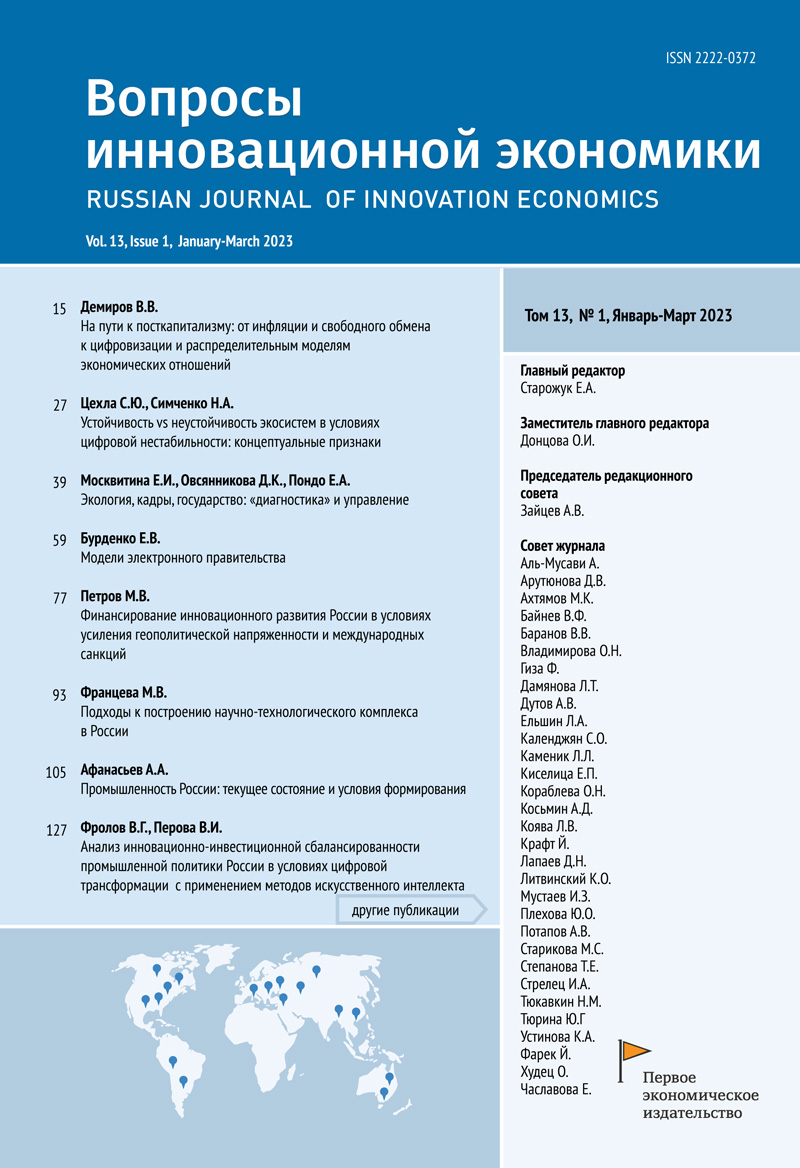Analysis of the Russian underwater robotics market
- Authors: Mitus K.N.1, Garmashova E.P.1
-
Affiliations:
- Sevastopol State University
- Issue: Vol 13, No 1 (2023)
- Pages: 233-254
- Section: Articles
- URL: https://journals.eco-vector.com/2222-0372/article/view/608072
- DOI: https://doi.org/10.18334/vinec.13.1.117357
- ID: 608072
Cite item
Abstract
The article is devoted to the urgent task of studying the features, trends and factors of the development of the Russian underwater robotics market. Until 2022, the vast majority of products in this market were imported. However, the introduction of a wide list of sanctions actualized the expediency of studying the underwater robotics market from the point of view of assessing the prospects for eliminating the resulting shortage of products by domestic manufacturers. In addition, the need to analyze the underwater robotics market is explained by a wide range of areas of its application: inspection of pipelines and other underwater man-made structures, monitoring of the seabed in ports and during the construction of underwater infrastructure, emergency rescue operations, monitoring of the chemical composition of water, meteorological observations, etc. The article discusses the global trends in the development of the underwater robotics market. The Russian market of underwater vehicles is analyzed. The key factors of its growth are highlighted. The main manufacturers are systematized; and the parameters of their products are analyzed. The analysis carried out in the article made it possible to propose ways to improve the production of domestic uninhabited underwater vehicles, namely: the creation of universal vehicles, that is, full-fledged marine robotic complexes, improving the control system of uninhabited underwater vehicles and buoys, increasing the technological level of research equipment, improving materials for construction, and increasing the energy capabilities of underwater vehicles.
About the authors
Kseniya Nikolaevna Mitus
Sevastopol State University
Email: KNMitus@sevsu.ru
Elena Petrovna Garmashova
Sevastopol State University
Email: epgarmashova@sevsu.ru
References
- Pobedin A.A. Reconsidering contemporary classifications of sanctions in the light of the Russia sanctions regime // R-Economy. – 2022. – № 3. – p. 196-207.
- Гармашова Е.П., Дребот А.М., Тарабардина М.Ю., Митус А.А., Баранов А.Г. Основные инструменты актуальных ограничительных мер в отношении России и Крыма // Управление экономикой, системами, процессами: В сборнике статей IV Международной научно-практической конференции. 2020. – c. 55-57.
- Andra-Teodora Nedelcu1, Nicolae Buzbuchi, Cătălin Faităr Underwater vehicle – their past, present and future development // Journal of Physics: Conference Series. – 2018. – № 1122. – doi: 10.1088/1742-6596/1122/1/012019.
- Yuh Junku, West Michael. Underwater robotics // Advanced Robotics. – 2001. – № 15. – p. 609-639. – doi: 10.1163/156855301317033595.
- Chutia Swagat, Kakoty Nayan, Deka Dhanapati. A Review of Underwater Robotics, Navigation, Sensing Techniques and Applications // Conference: the Advances in Robotics. – 2017. – № 1-6. – doi: 10.1145/3132446.3134872.
- Yang Cong, Changjun Gu, Tao Zhang, Yajun Gao. Underwater robot sensing technology: A survey // Fundamental Research. – 2021. – № 3. – p. 337-345.
- Digilina O., Teslenko I. The robotics market: development prerequisites, features and prospects // SHS Web of Conferences. – 2021. – № 101. – p. 02029. – doi: 10.1051/shsconf/202110102029.
- Gafurov S., Klochkov E. Autonomous unmanned underwater vehicles development tendencies // Procedia Engineering. – 2015. – № 106. – p. 141 – 148.
- Клименко Т.С., Ребельский А.Н. История развития обитаемых и необитаемых подводных аппаратов // Необитаемые подводные аппараты Проблемы развития корабельного вооружения и судового радиоэлектронного оборудования. – 2017. – № 1 (10). – c. 76-86.
- Курбанова Д. Факторы и тенденции развития как водной, так и подводной робототехники // Научный электронный журнал Меридиан. – 2019. – № 15 (33). – c. 627-629.
- Шматков А.А., Шматков А.Г., Сергейчиков О.А Современное состояние производства и перспективы развития серийных российских телеуправляемых необитаемых подводных аппаратов // Газовая промышленность. – 2020. – c. 156-160.
- Национальный стандарт Российской Федерации. Аппараты необитаемые подводные. Классификация. ГОСТ Р 56960-2016. Электронный фонд актуальных правовых и нормативно-технических документов. [Электронный ресурс]. URL: https://docs.cntd.ru/document/1200136057 (дата обращения: 05.02.2023).
- Bellingham J.G. Platforms: Autonomous Underwater Vehicles Encyclopedia of Ocean Sciences Reference Work Second Edition Editor-in-Chief: John H. Steele. Woods Hole, Massachusetts, USA: Marine Policy Center, Woods Hole Oceanographic Institution, 2009: 473-484
- Springer Handbook of Robotics Editors: Bruno Siciliano, Oussama Khatib. Heidelberg: Springer Berlin. 2008: 1611
- Официальный сайт Единой информационной системы в сфере закупок. [Электронный ресурс]. URL: https://zakupki.gov.ru/epz/main/public/home.html (дата обращения: 05.02.2023).
- Шувалов А.А. Необитаемые подводные аппараты. Классификация и технические характеристики НПА // Технические проблемы освоения Мирового океана. – 2011. – № 4. – c. 31-35.
- Мазулин Г.А. Отечественные необитаемые подводные аппараты // Морское оборудование и технологии. – 2020. – № 3-4 (24-25). – c. 52-54.
- Дулепов В.И., Лелюх Н.Н. Исследование и контроль состояния морских донных экосистем с использованием подводной робототехники // Гео-Сибирь. – 2007. – № 3. – c. 117-120.
- Занин В.Ю., Маевский А.М. Резидентная робототехника - современные технологии освоения шельфовых месторождений // Нефть. Газ. Новации. – 2021. – № 10 (251). – c. 46-47.
- Каримова Л.М. Подводная робототехника в сфере отдыха и туризма // Молодежь в науке: Новые аргументы: Сборник научных работ IV Международной молодежной научной конференции. 2018. – c. 57-60.
Supplementary files









